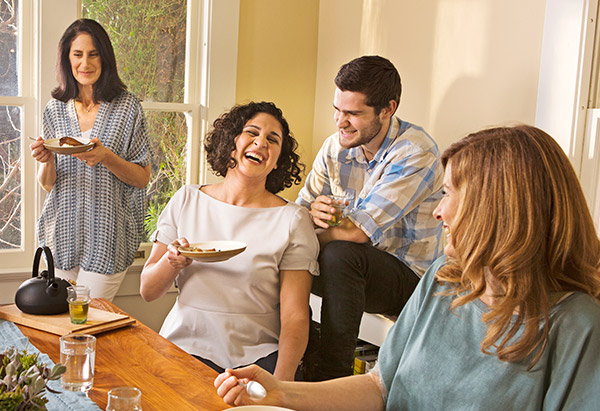What the Ultimate Food Expert Eats for Dinner
For years writer Michael Pollan has told us what to put on our plates. ("Eat food. Not too much. Mostly plants," he famously wrote.) Now he's learning what cooking is really all about: slowing down, enjoying the process, and filling the kitche

Photo: Coral Von Zumwalt
PAGE 3
Service with a smile: In the Pollan house, dinner is all about laughing, unwinding—and cooking—with good friends.
As Pollan's guests—all former students turned friends—arrive, they head instinctively for the kitchen, which is anchored by an island made from a slab of salvaged elm. "Whenever we entertain, we try to get people to gather in the living room for appetizers," Pollan says, "but they always end up gravitating toward here." While the cooking continues, the group enjoys canapés of Dungeness crab with preserved lemon and dill, someone spots a photo of a younger, impressively bearded Pollan in a straw hat ("I was in Mexico!" he protests), and the house begins to fill with the intoxicating, zingy fragrance of the main course: a vinegar-braised chicken.
The cooking of the meal isn't particularly quick, but considering its quality, it takes less time and effort than you might expect—a lesson that surprised him, says Pollan, and that he hopes to share with readers. "People might ask, 'How am I supposed to fit more kitchen time into my day?'" he says, pointing out research that shows Americans today, on average, spend about half the time preparing food that they did in the '60s. "But part of it has to do with how we've come to think about leisure. For some reason we've defined it as passive consumption, and we've learned to think of cooking as hard work. It's not hard. Even a novice can make food that's far better than a frozen dinner. And cooking is the best thing you can do for the health and well-being of your family." Friends, too: As everyone sits down at the table, it's clear that Pollan's hypothesis about the social nature of dining is well founded.
The chicken is deliciously tangy and vibrant, and the vegetable salad is simultaneously refreshing and rich. By the time Pollan brings out dessert—roasted pears with ricotta, honey, and black pepper—everyone looks happy, and perhaps slightly more than four-fifths full.
Next: How cooking can be a spiritual thing
As Pollan's guests—all former students turned friends—arrive, they head instinctively for the kitchen, which is anchored by an island made from a slab of salvaged elm. "Whenever we entertain, we try to get people to gather in the living room for appetizers," Pollan says, "but they always end up gravitating toward here." While the cooking continues, the group enjoys canapés of Dungeness crab with preserved lemon and dill, someone spots a photo of a younger, impressively bearded Pollan in a straw hat ("I was in Mexico!" he protests), and the house begins to fill with the intoxicating, zingy fragrance of the main course: a vinegar-braised chicken.
The cooking of the meal isn't particularly quick, but considering its quality, it takes less time and effort than you might expect—a lesson that surprised him, says Pollan, and that he hopes to share with readers. "People might ask, 'How am I supposed to fit more kitchen time into my day?'" he says, pointing out research that shows Americans today, on average, spend about half the time preparing food that they did in the '60s. "But part of it has to do with how we've come to think about leisure. For some reason we've defined it as passive consumption, and we've learned to think of cooking as hard work. It's not hard. Even a novice can make food that's far better than a frozen dinner. And cooking is the best thing you can do for the health and well-being of your family." Friends, too: As everyone sits down at the table, it's clear that Pollan's hypothesis about the social nature of dining is well founded.
The chicken is deliciously tangy and vibrant, and the vegetable salad is simultaneously refreshing and rich. By the time Pollan brings out dessert—roasted pears with ricotta, honey, and black pepper—everyone looks happy, and perhaps slightly more than four-fifths full.
Next: How cooking can be a spiritual thing



